The global label applicators market is valued at USD 3.2 billion in 2025 and is set to reach USD 5.8 billion by 2035, recording an absolute increase of USD 2.6 billion over the forecast period. This translates into a total growth of 81.3%, with the market forecast to expand at a CAGR of 6.1% between 2025 and 2035. The market size is expected to grow by approximately 1.8X during the same period, supported by increasing demand for automated packaging solutions, growing e-commerce activities, rising adoption of product identification systems, and expanding requirements for efficient labeling across manufacturing, logistics, and retail sectors.
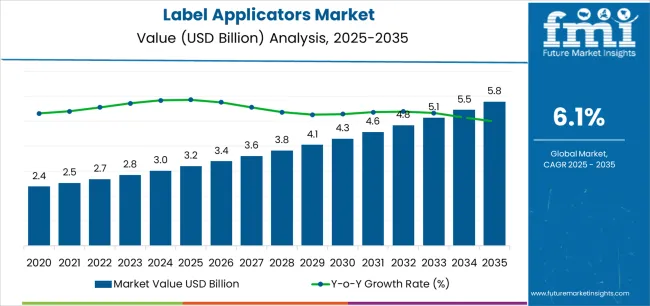
Between 2025 and 2030, the label applicators market is projected to expand from USD 3.2 billion to USD 4.3 billion, resulting in a value increase of USD 1.1 billion, which represents 42.3% of the total forecast growth for the decade. This phase of development will be shaped by increasing demand for automated labeling systems, rising barcode and QR code implementation enabling efficient inventory management, and growing availability of precision applicator solutions across manufacturing operations and distribution centers.
Between 2030 and 2035, the market is forecast to grow from USD 4.3 billion to USD 5.8 billion, adding another USD 1.5 billion, which constitutes 57.7% of the ten-year expansion. This period is expected to be characterized by the advancement of smart labeling technologies, the integration of IoT-enabled applicator systems for real-time monitoring, and the development of high-speed applicator formats across diverse industrial categories. The growing emphasis on product traceability and compliance requirements will drive demand for advanced applicator varieties with enhanced precision capabilities, improved speed control features, and superior reliability characteristics.
| Metric | Value |
|---|---|
| Estimated Market Value (2025E) | USD 3.2 Billion |
| Forecast Market Value (2035F) | USD 5.8 Billion |
| Forecast CAGR (2025-2035) | 6.10% |
The packaging machinery market is the largest contributor, accounting for approximately 40–45%, as label applicators are essential in automating the application of labels across various packaging types, such as bottles, jars, and boxes. The manufacturing equipment market adds around 20–25%, as label applicators are crucial in streamlining production processes across industries like food, beverages, pharmaceuticals, and cosmetics. The consumer goods packaging market contributes about 15–18%, with label applicators used for labeling personal care items, household products, and more, ensuring consistent branding and regulatory compliance.
The food and beverage packaging market accounts for roughly 10–12%, as the demand for efficient labeling systems in food products drives market growth. As labeling technology improves, label applicators provide greater speed and accuracy, which is crucial for large-scale food production. The pharmaceutical packaging market adds approximately 8–10%, as precise and reliable labeling is essential for pharmaceutical products to ensure proper dosage, safety, and regulatory adherence. These parent markets drive the label applicators market by pushing for higher efficiency, better adhesion, and cost-effective solutions in automated labeling across various industries, while also responding to the evolving needs of consumers and regulatory standards.
Market expansion is being supported by the increasing global demand for automated labeling solutions and the corresponding shift toward precision applicator formats that can provide superior labeling accuracy while meeting user requirements for speed optimization and error-free application processes. Modern businesses are increasingly focused on incorporating applicator systems that can enhance production efficiency while satisfying demands for consistent, reliably performing mechanisms and optimized manufacturing practices. Label applicators' proven ability to deliver precise positioning, extended operational reliability, and diverse application possibilities makes them essential equipment components for manufacturing operators and quality-conscious production managers.
The growing emphasis on regulatory compliance and product identification is driving demand for high-performance label applicator systems that can support traceability-focused positioning and comprehensive labeling benefits across industrial products, pharmaceutical applications, and food processing categories. User preference for applicator mechanisms that combine operational excellence with maintenance efficiency is creating opportunities for innovative implementations in both traditional and emerging manufacturing applications. The rising influence of e-commerce platforms and modern distribution infrastructure is also contributing to increased adoption of label applicators that can provide reliable identification and efficient processing characteristics.
The market is segmented by product type, technology, application method, end-use industry, and region. By product type, the market is divided into automatic applicators, semi-automatic applicators, and manual applicators. Based on technology, the market is categorized into pressure-sensitive, blow-on, tamp-blow, and wipe-on systems. By application method, the market includes flat surface, curved surface, and wrap-around labeling. By end-use industry, the market encompasses food & beverage, pharmaceuticals, cosmetics & personal care, manufacturing, and other applications. Regionally, the market is divided into North America, Europe, Asia Pacific, Latin America, Middle East & Africa, and other regions.
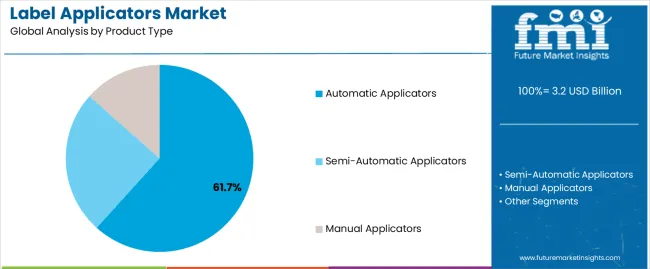
The automatic applicators segment is projected to account for 61.7% of the label applicators market in 2025, reaffirming its position as the leading product category. Businesses and manufacturing facilities increasingly utilize automatic applicators for their superior speed characteristics, established efficiency benefits, and essential functionality in high-volume labeling applications across multiple production environments. Automatic applicators' standardized performance characteristics and proven reliability directly address user requirements for consistent production throughput and optimal equipment value in industrial applications.
This product segment forms the foundation of modern labeling patterns, as it represents the format with the greatest operational versatility and established compatibility across multiple product types. Business investments in automation enhancement and precision standardization continue to strengthen adoption among performance-conscious operators. With users prioritizing speed consistency and accuracy control, automatic applicators align with both operational objectives and productivity requirements, making them the central component of comprehensive manufacturing strategies.
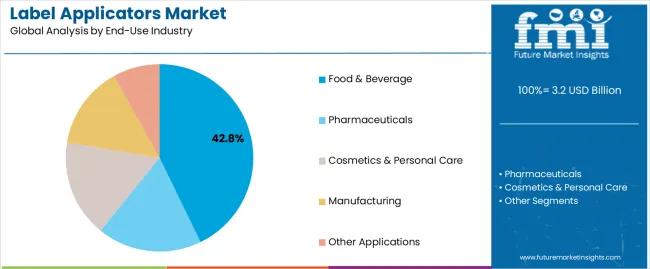
Food & beverage is projected to represent 42.8% of the label applicators market in 2025, underscoring its critical role as the primary industry for efficiency-focused businesses seeking superior labeling benefits and enhanced production convenience credentials. Commercial users and food brands prefer food & beverage applications for their established high-volume positioning, proven regulatory compliance, and ability to maintain exceptional identification profiles while supporting diverse product offerings during various packaging processes. Positioned as essential applications for quality-conscious operators, food & beverage offerings provide both operational efficiency excellence and cost-effective advantages.
The segment is supported by continuous improvement in applicator technology and the widespread availability of customization options that enable brand distinction and premium positioning at the consumer level. Equipment companies are optimizing applicator designs to support product identification and accessible labeling strategies. As applicator technology continues to advance and manufacturers seek efficient packaging formats, food & beverage applications will continue to drive market growth while supporting operational efficiency and quality assurance strategies.
The label applicators market is advancing rapidly due to increasing industrial automation demand and growing need for precision labeling mechanisms that emphasize superior accuracy outcomes across manufacturing segments and packaging applications. The market faces challenges, including complexity in system integration, compatibility issues with certain product formats, and cost pressures affecting advanced applicator adoption. Innovation in smart applicator systems and IoT-enabled technologies continues to influence market development and expansion patterns.
The growing adoption of label applicators in automated manufacturing is enabling businesses to develop production patterns that provide distinctive efficiency benefits while commanding operational confidence and enhanced throughput reliability. Automation applications provide superior speed properties while allowing more sophisticated control features across various product categories. Users are increasingly recognizing the operational advantages of label applicator positioning for integrated manufacturing and efficiency-conscious production integration.
Modern label applicator manufacturers are incorporating advanced IoT technologies, real-time monitoring concepts, and cloud-based control systems to enhance operational visibility, improve maintenance management, and meet commercial demands for reduced downtime impact. These systems improve equipment effectiveness while enabling new applications, including predictive maintenance programs and remote monitoring solutions. Advanced connectivity integration also allows manufacturers to support Industry 4.0 positioning and operational objectives beyond traditional labeling operations.
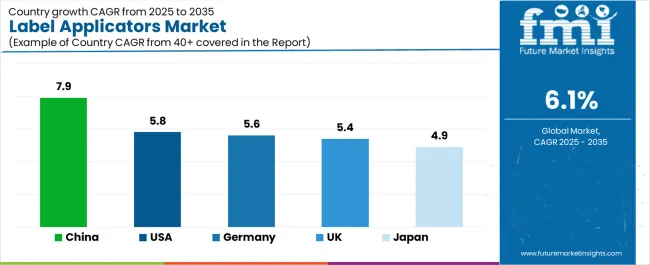
| Country | CAGR (2025-2035) |
|---|---|
| USA | 5.8% |
| Germany | 5.6% |
| UK | 5.4% |
| China | 7.9% |
| Japan | 4.9% |
The label applicators market is experiencing robust growth globally, with China leading at a 7.9% CAGR through 2035, driven by the expanding manufacturing industry, growing automation adoption, and increasing implementation of advanced labeling systems. The USA follows at 5.8%, supported by rising industrial automation demand, expanding packaging applications, and growing acceptance of innovative applicator solutions. Germany shows growth at 5.6%, emphasizing established manufacturing capabilities and comprehensive automation innovation. The UK records 5.4%, focusing on premium labeling systems and industrial sophistication. Japan demonstrates 4.9% growth, prioritizing precision applicator solutions and technological advancement.
The report covers an in-depth analysis of 40+ countries, with top-performing countries highlighted below.
Revenue from label applicator consumption and sales in the USA is projected to exhibit exceptional growth with a CAGR of 5.8% through 2035, driven by the country's rapidly expanding automation sector, favorable industrial attitudes toward precision equipment, and initiatives promoting innovative applicator mechanisms across major manufacturing regions. The USA's position as a leading industrial market and increasing focus on automation-conscious production development are creating substantial demand for high-quality label applicators in both commercial and specialty markets. Major manufacturing companies and equipment producers are establishing comprehensive automation capabilities to serve growing demand and emerging market opportunities.
Demand for label applicator products in Germany is expanding at a CAGR of 5.6%, supported by rising manufacturing sophistication, growing automation requirements, and expanding production infrastructure. The country's developing technical capabilities and increasing commercial investment in precision engineering are driving demand for label applicators across both imported and domestically produced applications. International equipment companies and domestic manufacturers are establishing comprehensive operational networks to address growing market demand for quality labeling systems and efficient automation solutions.
Revenue from label applicator products in the UK is projected to grow at a CAGR of 5.4% through 2035, supported by the country's mature manufacturing market, established industrial culture, and leadership in automation innovation. Britain's sophisticated industrial base and strong support for premium equipment are creating steady demand for both traditional and innovative label applicator varieties. Leading manufacturing brands and specialty producers are establishing comprehensive operational strategies to serve both domestic markets and growing export opportunities.
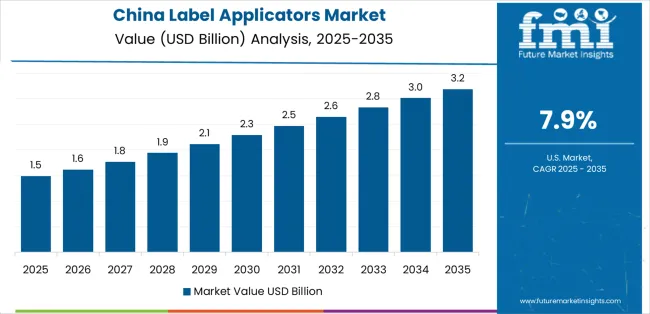
Demand for label applicator products in China is anticipated to expand at a CAGR of 7.9% through 2035, driven by the country's emphasis on industrial expansion, manufacturing leadership, and sophisticated production capabilities for equipment requiring specialized precision varieties. Chinese manufacturers and industrial brands consistently seek commercial-grade automation that enhances production efficiency and supports manufacturing operations for both traditional and innovative industrial applications. The country's position as an Asian manufacturing leader continues to drive innovation in specialty label applicator applications and commercial production standards.
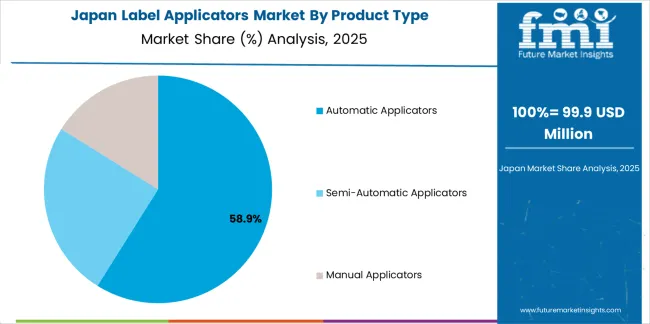
Revenue from label applicator products in Japan is expected to grow at a CAGR of 4.9% through 2035, supported by the country's emphasis on precision manufacturing, equipment reliability, and advanced technology integration requiring efficient labeling solutions. Japanese businesses and industrial brands prioritize applicator accuracy and manufacturing precision, making label applicators essential equipment for both traditional and modern production applications. The country's comprehensive quality excellence and advancing automation patterns support continued market expansion.
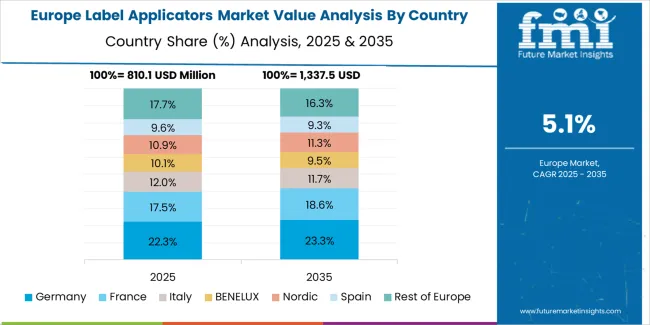
The Europe label applicators market is projected to grow from USD 1.1 billion in 2025 to USD 2.0 billion by 2035, recording a CAGR of 5.9% over the forecast period. Germany leads the region with a 35.2% share in 2025, moderating slightly to 34.8% by 2035, supported by its strong manufacturing base and demand for premium, technically advanced applicator products. The United Kingdom follows with 21.8% in 2025, easing to 21.4% by 2035, driven by a sophisticated industrial market and emphasis on automation innovation and precision excellence. France accounts for 16.7% in 2025, rising to 17.1% by 2035, reflecting steady adoption of premium automation solutions and manufacturing innovation. Italy holds 12.3% in 2025, expanding to 12.7% by 2035 as industrial automation and specialty applicator applications grow. Spain contributes 7.4% in 2025, growing to 7.8% by 2035, supported by expanding manufacturing sector and premium equipment adoption. The Nordic countries rise from 4.2% in 2025 to 4.4% by 2035 on the back of strong technology adoption and advanced automation integration. BENELUX declines from 2.4% in 2025 to 1.8% by 2035, reflecting market maturity and regional consolidation.
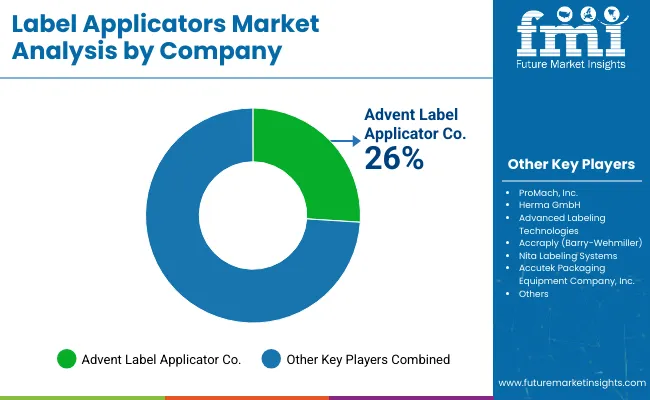
The label applicators market is characterized by competition among established automation manufacturers, specialized applicator producers, and integrated labeling solution companies. Companies are investing in precision servo technologies, advanced sensor systems, product innovation capabilities, and comprehensive customization networks to deliver consistent, high-quality, and reliable label applicator systems. Innovation in smart technology, IoT-enabled controls, and application-specific product development is central to strengthening market position and customer satisfaction.
Markem-Imaje Corporation leads the market with a strong focus on applicator innovation and comprehensive labeling solutions, offering commercial applicator systems with emphasis on engineering excellence and technological heritage. Videojet Technologies provides specialized coding and marking capabilities with a focus on global market applications and applicator engineering networks. Domino Printing Sciences delivers integrated identification solutions with a focus on applicator positioning and operational efficiency. Avery Dennison Corporation specializes in comprehensive labeling systems with an emphasis on commercial applications. 3M Company focuses on comprehensive industrial adhesives and labeling with advanced design and premium positioning capabilities.
The success of label applicator systems in meeting commercial automation demands, manufacturer-driven efficiency requirements, and performance integration will not only enhance industrial production outcomes but also strengthen global manufacturing capabilities. It will consolidate emerging regions' positions as hubs for efficient equipment production and align advanced economies with commercial automation systems. This calls for a concerted effort by all stakeholders -- governments, industry bodies, manufacturers, distributors, and investors. Each can be a crucial enabler in preparing the market for its next phase of growth.
How Governments Could Spur Local Production and Adoption?
How Industry Bodies Could Support Market Development?
How Distributors and Industrial Players Could Strengthen the Ecosystem?
How Manufacturers Could Navigate the Shift?
| Item | Value |
|---|---|
| Quantitative Units (2025) | USD 3.2 billion |
| Product Type | Automatic Applicators; Semi-Automatic Applicators; Manual Applicators |
| Technology | Pressure-Sensitive; Blow-On; Tamp-Blow; Wipe-On |
| Application Method | Flat Surface; Curved Surface; Wrap-Around |
| End-Use Industry | Food & Beverage; Pharmaceuticals; Cosmetics & Personal Care; Manufacturing; Other Applications |
| Regions | North America; Europe; Asia Pacific; Latin America; Middle East & Africa; Other Regions |
| Key Countries | United States; Germany; United Kingdom; China; Japan; and 40+ additional countries |
| Key Companies | Markem-Imaje Corporation; Videojet Technologies; Domino Printing Sciences; Avery Dennison Corporation (profiled); 3M Company; Other leading label applicator companies |
| Additional Attributes | Dollar sales by product type, technology, application method & end-use industry; Regional demand trends; Competitive landscape; Technological advancements in applicator engineering; Smart technology integration initiatives; IoT-enabled applicator programs; Premium product development strategies |
The global label applicators market is estimated to be valued at USD 3.2 billion in 2025.
The market size for the label applicators market is projected to reach USD 5.8 billion by 2035.
The label applicators market is expected to grow at a 6.1% CAGR between 2025 and 2035.
The key product types in label applicators market are automatic applicators , semi-automatic applicators and manual applicators.
In terms of end-use industry, food & beverage segment to command 42.8% share in the label applicators market in 2025.






Full Research Suite comprises of:
Market outlook & trends analysis
Interviews & case studies
Strategic recommendations
Vendor profiles & capabilities analysis
5-year forecasts
8 regions and 60+ country-level data splits
Market segment data splits
12 months of continuous data updates
DELIVERED AS:
PDF EXCEL ONLINE
Key Players & Market Share in the Label Applicators Industry
Robot Label Applicators Market
Labeling and Coding Equipment Market Size and Share Forecast Outlook 2025 to 2035
Labels Market Analysis - Size, Share, and Forecast Outlook 2025 to 2035
Labels, Tapes And Films Market Size and Share Forecast Outlook 2025 to 2035
Labeling Equipment Market Analysis - Size, Share, and Forecast Outlook 2025 to 2035
Label Printers Market Size, Growth, and Forecast 2025 to 2035
Labelling Machine Market Growth & Industry Trends through 2035
Competitive Overview of Labels Companies
Competitive Breakdown of Labeling Equipment Providers
Labeling Software Market Growth - Trends & Forecast through 2034
Label Printing Software Market – Smart Labeling & Automation
GHS Label Market Size and Share Forecast Outlook 2025 to 2035
USA Labels Market Size and Share Forecast Outlook 2025 to 2035
GMO Labelling Market Size and Share Forecast Outlook 2025 to 2035
Top Labelling Equipment Market Trends - Growth & Forecast 2025 to 2035
Market Share Distribution Among USA Labels Providers
Leading Providers & Market Share in GHS Label Industry
Foam Labels Market Trends and Growth 2035
Market Share Breakdown of Foil Labels Manufacturers

Thank you!
You will receive an email from our Business Development Manager. Please be sure to check your SPAM/JUNK folder too.
Chat With
MaRIA